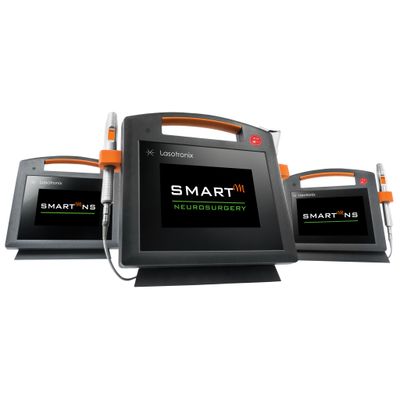

- Home
- Companies
- Lasotronix Sp. z o.o.
- Products
- SMARTM - Model NS - Percutaneous Laser ...

SMARTM - Model NS - Percutaneous Laser Disc Decompression (PLDD)
Percutaneous laser disc decompression (PLDD) is a minimally invasive procedure that aims to significantly reduce the patient’s pain and reduce the neurological deficit.
- Simple and intuitive operation
- Greater precision of treatments with reduced tissue invasiveness
- Quick return to daily activities
- Pain reduction
- No need for hospitalization
- Lowest operating costs
- Percutaneous Laser Disc Decompression (PLDD)
In 1986, Peter Ascher and Daniel Choy at the Department of Neurosurgery at the University of Graz in Austria performed the first percutaneous laser disc compression procedure in the lumbar spine.
Since 1987, percutaneous laser disc decompression (PLDD) has been used in the clinical treatment of prolapsed intervertebral discs. Since then, the PLDD technique has spread all over the world, and procedures are performed all over the spine, except for T1 – T4 (these discs do not allow percutaneous access with a needle). This method is widespread in the United States.
The first experimental treatments were carried out on animal intervertebral discs with the use of a neodymium-jag laser – Nd: YAG. The first clinical procedure in history was performed with this laser model. Work on the use of different types of laser led to the introduction of a diode laser into clinical practice.
In Poland, diode laser treatments have been performed since 2003 at the Department of Neurosurgery of the Central Teaching Hospital of the Ministry of Interior and Administration in Warsaw.
Why is there no single wavelength?
Diode lasers are one of the most efficient converters of electricity to laser light. Thanks to diode lasers, it is possible to induce various tissue reactions, for example coagulation, evaporation or bonding. Diode lasers provide a fairly deep tissue penetration. Various effects can be obtained by changing the laser parameters accordingly, which allows for a wide range of possible applications.
SMARTMNS is a laser system that includes a 980 nm diode source and combines the latest technology with ease of use. This combination enables minimally invasive percutaneous disc decompression to be successfully performed. The 980 nm laser radiation is perfectly absorbed by hemoglobin and water molecules, so SMART MNS allows you to obtain the vaporization and coagulation effect (without thermal damage). The advantage of optical ablation is that it causes less damage to the surrounding tissues, as well as allows for better hemostasis and permanent effects. SMARTM NS1 is a step forward in laser technology, enabling tissue vaporization, ablation and controlled penetration depth
Technical data:
- Laser type: diode
- Output power: up to 10 W
- Screen: color, touchscreen
- Fiber diameter: 320μm, 400μm, 600μm
- Weight: 2.5 kg


